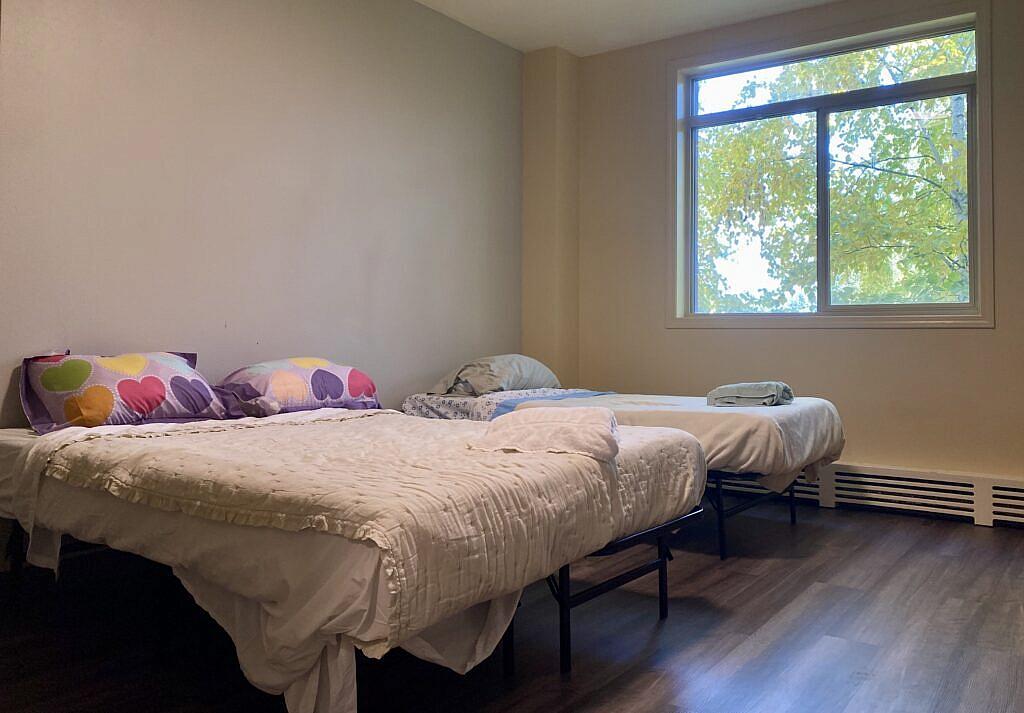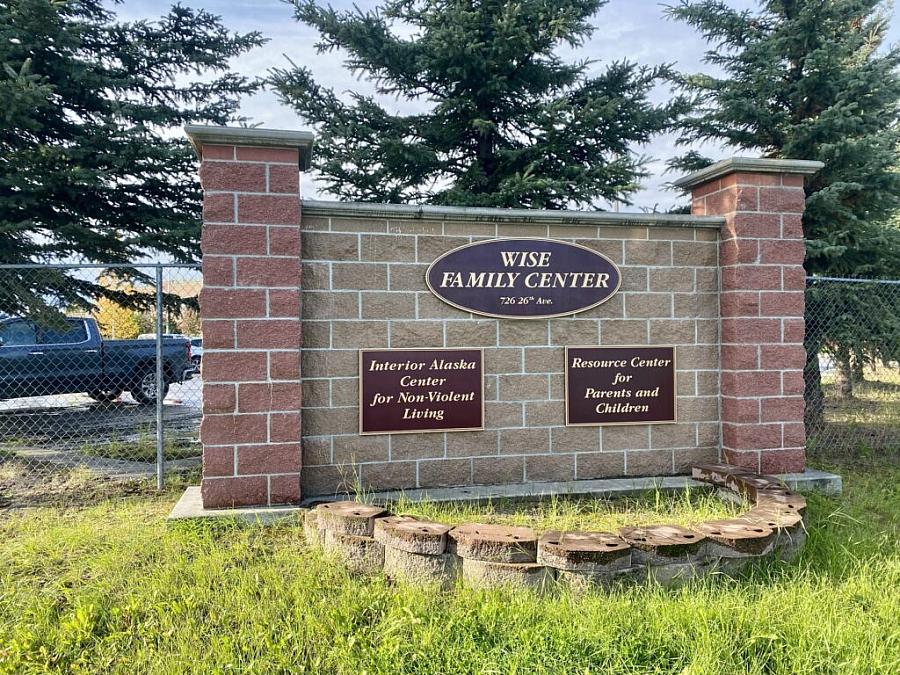Alaska pays millions to respond to domestic violence. Advocates want millions to prevent it.
The story was originally published by Alaska Beacon with support from our 2023 Domestic Violence Impact Fund.

Freshly made beds are seen in an unoccupied room at the Fairbanks emergency shelter, Interior Alaska center for Non-Violent Living on Oct. 14, 2023.
Photo by Claire Stremple/Alaska Beacon
When Kara Carlson experienced sexual assault as a teenager, she said it was traumatic but not shocking: “I was the last of my friends to experience sexual violence,” she said. “We live in this world where you have to prepare women for surviving trauma.”
She now runs the women’s emergency shelter, Interior Alaska Center for Non-Violent Living, where she has worked for nearly two decades. She has seen domestic and sexual violence affect generations of Alaskans in Fairbanks.
“I’ve been here long enough that I’ve seen moms come in, I’ve seen their kids come in. I’ve seen their kids in CourtView as perpetrators. We’ve served their kids as victims,” she said, adding that she has seen up to three generations pass through IAC’s doors. “The cycle keeps repeating because nothing — nothing’s changed.”

A sign outside of the emergency shelter in Fairbanks, Alaska on September 14, 2023. Executive director Kara Carlson said she has seen generations of families pass through its doors.
Photo by Claire Stremple/Alaska Beacon
Without prevention services, Carlson said, the shelter cannot reduce violence: “We will operate like this forever and ever, with no change in numbers, because the shelter is a Band-Aid, is the place people come after something has happened.”
Despite the millions the state of Alaska spends on domestic violence programming, its families still experience some of the highest rates of domestic violence in the nation. Experts and advocates agree that significant increases in prevention work and community level support are necessary to slow the rate of domestic violence.
Studies show that children who are exposed to violence are more likely to perpetrate it. They are also more prone to struggle academically or have negative mental and physical health outcomes.
Interior Alaska Center for Non-Violent Living has prevention services, including a rehabilitation program that teaches perpetrators alternatives to violence. But Carlson said if she cannot find more funding to run that program, she may have to end it — even though she knows it can be effective.
“That’s where we have really failed in domestic violence”
Diane Casto, former director of the state’s Council on Domestic Violence and Sexual Abuse, said that, while government funding fuels the nonprofits and agencies that tend to domestic violence, only social change can stamp it out. And, from where she sits, the route to social change is community level prevention work.
Ninety percent of our grant dollars go to victim services, 8% go to prevention, and 2% go to batterer intervention programs.
– Diane Casto, former director of the Council on Domestic Violence and Sexual Abuse
Prevention, in the context of domestic violence, is usually education around healthy relationships. It can be aimed at youth, at adults in relationships, or even people who have caused harm.
“My goal since I started here in 2017 was to bring prevention up, bring services to those who harm up,” she said. Funding for prevention has increased slightly since she started, but ultimately, Casto said it is where the state has failed in its fight against domestic violence.
“We have a lot of grant money,” Casto said. Yearly, CDVSA distributes more than $20 million in grants statewide.
But she said there is an imbalance that thwarts their ultimate goal of ending violence: “Ninety percent of our grant dollars go to victim services, 8% go to prevention, and 2% go to batterer intervention programs,” she said.
In other words, most of the state’s investment in domestic violence goes to helping people after the violence happens. Casto said to actually end domestic violence, she needs prevention to be funded at the same rate as victim services. But she said that’s a tough ask because prevention work is time consuming and it is hard to demonstrate success.
“Prevention takes years — generations — to change attitudes, beliefs and behaviors. And if you don’t give it that time, you’re not going to see change. And I think that’s where we have really failed in domestic violence,” she said. “Funding wants to see results and outcomes now.”
Casto said each year, she asks the state Legislature for more funding because the need for victim services is so great. She wants to invest in prevention so that, one day, the budget needed to protect people in crisis will shrink.
“The reality is: If we keep turning our head, if we don’t take responsibility, then it isn’t going to end,” she said.
Alaska’s prevention movement
There was a time when the state invested more heavily in prevention and domestic violence awareness, said Brenda Stanfill, who runs the state’s coalition of domestic violence shelters, called the Alaska Network on Domestic Violence and Sexual Assault.
Stanfill said former Gov. Sean Parnell’s Choose Respect campaign and his investment in domestic violence prevention programs jump-started the movement to increase awareness and reduce domestic violence.
“In 2010 to 2015, we did a lot of things. We started talking about it very openly,” she said. “Prevention started in those five years. That was the first time we started doing prevention — violence prevention awareness and violence prevention activities out in villages and communities and urban hubs.”
She said kids did projects in school where they learned about healthy conflict resolution — and brought their new knowledge home to their parents. She said children’s observations could be a wake-up call for people who didn’t recognize their own damaging behavior: “If you have kids talking about what is respect, and how do we treat one another, and then maybe pointing out at home, ‘That’s not what I learned at school’ kind of thing — that works. It puts pressure,” she said.
That era was also the birth of what are called “batterer intervention programs,” a name Stanfill said she now regrets because of the way it labels perpetrators. The programs are for people who have perpetrated domestic violence, and they are aimed at teaching them nonviolent methods for resolving conflict.
Stanfill and other experts in the field have said those programs work if the offender is open to change, and she has seen how the classes can be effective. She recalled one session, where men were asked about conflict at home when they were growing up. One man said his family did not have that experience: if his mom got upset, his father would slap her, and the conflict would end. “He wasn’t being sarcastic. Truly, to him, that was no conflict,” she said. “There’s no conflict in his mind, so he’s got no other skills. That’s all he’s got.” The coursework provided him with nonviolent alternatives.
In 2009, Parnell pledged to end domestic violence in the state within a decade. His attorney general, now U.S. Sen. Dan Sullivan, vowed to increase prosecution for offenders. The Alaska Victimization Survey showed that then, between 2010 and 2015, there was a decrease in domestic violence. The latest survey, from 2015 to 2020, shows the rate has crept back up and is higher than it has been in the last decade.
Stanfill said the prevention movement was important because it got people talking about a subject that was once taboo. Now, she said nonviolence advocates need to take the next step.
“I don’t think we’ve given the answer for what we now need to do,” she said. “When it comes to domestic violence, I think that we’re still trying to figure out exactly what call to action are we doing? And I think that that’s something that we really, as a state, have got to spend some time thinking about.”

